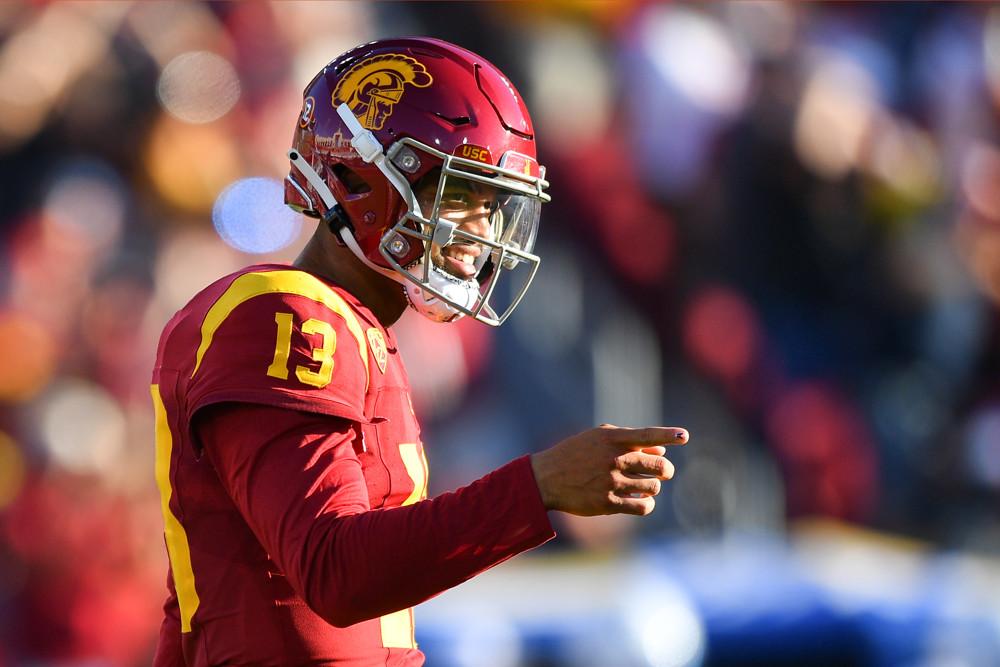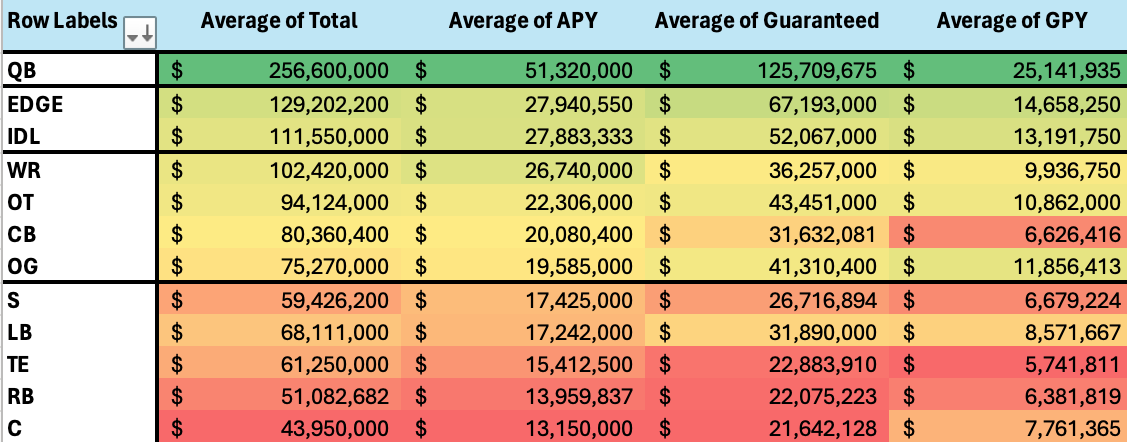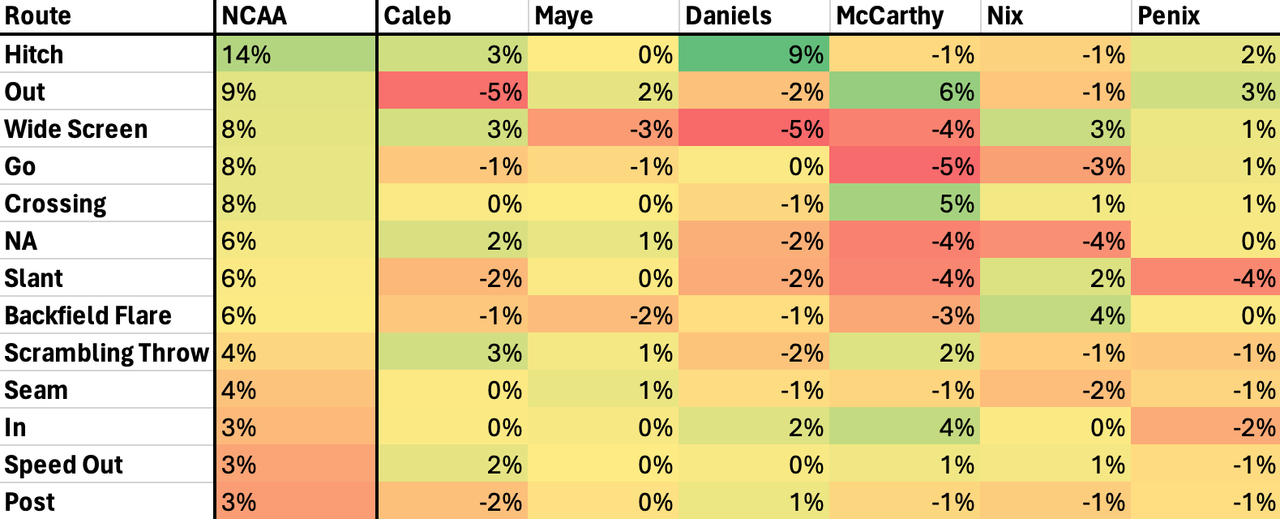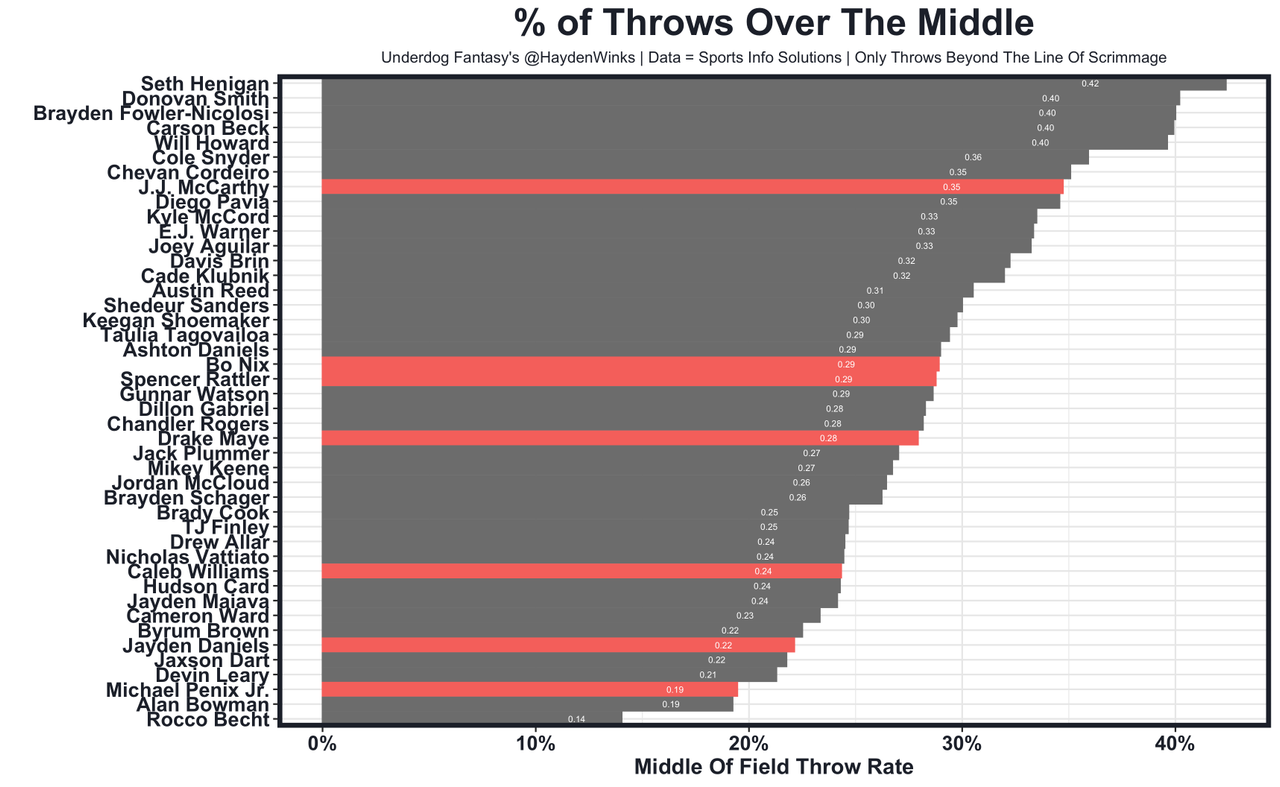2024 NFL Draft QB Rankings, Grades, and Profiles

Before we get to the QB prospect reports, I have a peeve.
What's up with draft grades that don't tell you specifically where you'd draft each prospect? How is an arbitrary number helpful? How is a draft grade that doesn't incorporate positional value helpful? When a team is on the clock, they draft the most valuable prospect. Ultimately, rankings are the only relevant thing when on the clock, and ultimately, draft grades/tiers are the only relevant thing when thinking about moving up or down the board via trade.
Oh, and enough with the "he's a Round 2 grade but I'd draft him in Round 1" stuff with QBs. Just call them a Round 1 QB then. We already do the positional value adjusting with some positions (do you see the top graded center early in Round 1?). Let's just keep it consistent for all positions. As you'll see, my grades are literally where I'd take these prospects if I were on the clock for the average team. There's no mind games here. Just straight forward grades that I can keep year-over-year so I can compare prospects over time. In fact, you'll see my historical grades at the end of the column.
Specifically for QB grades, the potential value gained by hitting on a QB means there will be a lot of Round 1 grades, even for flawed prospects. Just look at the table below to see how much the top 5 QBs are paid in free agency compared to literally every other position's top 5 players. It'd be easier to just fade every QB by handing out Round 2/3 grades because most QB prospects bust, but the upside of hitting on one is worth some misses. Remember, highly-rated EDGEs, OTs, WRs, and CBs bust all the time. If you pass on that imperfect QB, your team is still at risk of drafting a bust at a position that doesn't hold the upside of the QB. Don't be scared to whiff.

QB1 Caleb Williams (Grade: 1st Overall Pick)
QB Model: 98th percentile
Comps: Smaller Patrick Mahomes, Bigger Kyler Murray
Since giving out prospect grades in 2021, I've had five 1st overall pick grades. They are Trevor Lawrence, Justin Fields, C.J. Stroud, and now Caleb. I'd take him over all of them because none have had his combination of arm talent, play-making ability, and feel for the game. Williams had 92nd percentile passing and 93rd percentile rushing EPA as a true sophomore, then he dipped to the 80th percentile in QB rating with a worse supporting cast in his final season at USC. His OL was the worst of the top QB prospects, his perimeter talent was average at best, and the defense had Alex Grinch at coordinator. Perhaps more maddening than all was the wasted plays. For example, Williams threw by far the most screens in the Power 5 (137), yet they had a 34% success rate and 6.0 yards per attempt. Maddening!
As for his own traits, Williams' pocket navigation and ability to find a throwing window while working to his left or right is unbelievable. He routinely steps up in the pocket, escapes free rushers to the boundary, and can take a hit inside the pocket to get to a backside throw. The entire playbook is available. Williams had a lot of quick-game throws in USC's air raid offense as a version of a "run game", but his raw arm strength is one of his top traits. He can throw it 65 yards with his feet set, or on the run with both accuracy and velocity. He also averaged +0.45 EPA per play on scrambles and broken plays because of his rushing athleticism. Only so many people on the planet can do all that at his level.
Williams' feel for the game, anticipation, and ability to get through progressions goes overlooked because of his wow moments. Williams had +0.54 EPA per play on the classic timing routes (slants, comebacks, curls, digs, outs) from inside the pocket because he's a twitchy thrower and has great knowledge of defenses. He threw an above average amount of hitch routes with great success, largely because of his pre-snap reads. He also threw with the correct trajectory based on defensive alignments when scrambling around post-snap.

This chart shows how often each QB threw the most common routes relative to the average college QB. For example, the average QB threw the hitch route on 14% of attempts, while Caleb Williams threw them 17% of the time (+3% in the table). Data from PFF.
For as often as he was forced to make a play, Williams' 1% interception rate is remarkable. His 5 INTs included a 50/50 ball (bad WR play), a miscommunication by a WR, an overthrown RPO against a free rusher, and then two dangerous throws out of structure. His 16 "fumbles" included 5 that were completely his fault, 4 strip sacks, 3 mesh-point fails on zone reads with the RB, 3 bad snaps, and 1 dropped snap that turned into a 76-yard passing touchdown. You can make a negative play compilation for clout, but Williams is actually careful with the ball for how much he had to do.
Cleaning up some of the unforced errors is an obvious room for an improvement, but where Williams does need to actually improve is by staying consistent with his feet. There were times where he'd rely on his freakish arm talent rather than setting his feet, leading to some erratic throws. It happened on RPOs in particular. As we've seen with Patrick Mahomes, Williams will have to evolve over time. I believe he'll be able to because it's clear he loves ball, puts in the work, and has time to develop. After all, he'll be 22 years old during most of his rookie season.
QB2 Drake Maye (1st/2nd Overall Pick)
QB Model: 95th percentile
Comps: Jordan Love, Deshaun Watson, Young Josh Allen
With a better supporting cast in 2022 under OC Phil Longo (air raid), Maye led college football in total EPA (+115.4), but things regressed as a junior in a sub-par environment with a new coordinator. His final season fell into the 78th percentile in QBR, 66th percentile in EPA per play, 93rd percentile in rushing EPA, and 48th percentile in passing EPA, so Maye's profile definitely requires projection. The good news is he's a toolsy player with ideal size, arm talent, and athletic ability. He doesn't touch Josh Allen in any of those categories, but he's not far off either. Like Allen, there are some questionable decisions sprinkled throughout his tape, likely because he's so young. If things click moving forward, Maye has borderline top 5 QB potential in the tier of Dak Prescott, Trevor Lawrence, CJ Stroud, Matthew Stafford, and Jalen Hurts.
Maye has flashed the ability to make every throw, primarily out of shotgun. He has the arm strength for go balls, sideline throws, and tight window passes over the middle of the field. He can also throw on the run to both sides because he's a physically strong athlete. On occasion, Maye can layer in throws with touch, though that's far more of a work in progress. His feet can heel click and his base can squat up and down too much, leading to inaccurate passes. Maye's 71% catchable ball rate on clean passes 15+ yards downfield is definitely below average, and his EPA generated on the classic timing routes underneath was the worst of the consensus top prospects:
What's frustrating is he actually does throw with anticipation and does attack the middle of the field. Per SIS, 10% of Maye's passes were digs or crossing routes over the middle. That only trails J.J. McCarthy and generally is a high mark. He can make those throws because he's tall (vision line matters) and is willing to take a hit in the pocket while the backside route develops. Maye simply has to be more accurate to have these Matthew Stafford like throws be a staple of his game. That said, Maye does hold onto the ball a little longer than needed at times, leading to some iffy sacks. His 20% pressure-to-sack rate is a little worrisome, and PFF credited Maye with 26% of the responsibility that there was pressure. The latter was 7th worst out of 71 Power 5 qualifiers. Compared to drafted QBs since 2000, Maye's EPA lost due to sacks is in the bottom 25th percentile. Once again, supporting cast and being young are factors.
While his feet, accuracy, and pocket awareness improve with more experience, Maye has a fantastic trait to fall back to: scrambling. He's finished 1st and 4th in first downs on scrambles in all of college football over the last two seasons. Last year's 52% first down rate on his scrambles was 2nd best, too, so he's not doing it recklessly. Maye has feel for when to take off and the athletic traits to finish off runs. Overall, there are similarities to Anthony Richardson's profile as a prospect in development with all the tools to believe in. He needs more coaching. He needs more live reps. But there are too many flashes of NFL throws and runs to not be enamored with the upside. And for his collegiate flaws, Maye certainly made a lot of full-field reads and wow plays with his legs.
QB3 J.J. McCarthy (1st/2nd Overall Pick)
QB Model: 85th percentile
Comps: Alex Smith, Joe Burrow if you want to dream in 2-3 years
Michigan led at halftime in every game with an average 13.2 point lead, so McCarthy only threw 22 passes per game as a true junior during their undefeated National Championship run. Typically that's a very bad sign, but Jim Harbaugh did the same with Andrew Luck at Stanford and more importantly, McCarthy was efficient when asked to throw. His EPA per play (93rd percentile), QB rating (95th percentile), and rushing EPA (63rd percentile) were well above average among drafted QBs since 2000.
His evaluation is complex because McCarthy was arguably the worst of the top-6 QBs based on his 2023 tape, but he also was 20 years old. His body is simply not fully developed yet. McCarthy is a lose athlete with plenty of line-drive arm strength, even on the move, but he needs to get stronger. There were deep passes that died out. There were also missed sideline throws because he was really stepping into things, resulting in the lowest on-target rate on sideline throws with 10+ air yards of the top prospects. While concerning, biology suggests those problems will age out once he adds 10-20 pounds to his frame in the NFL. If arm strength (and the footwork/accuracy attached to it) is his biggest flaw, there's at least hope it gets fixed over time. After all, McCarthy was a 5-star recruit out of the IMG Academy. There's a strong athlete in there waiting to be developed.

The Wolverines did put McCarthy into some tough 3rd-and-long situations because of their early-run tendencies, and he delivered. In fact, his 10.9 YPA on 3rd-and-6 plus attempts led the class. For someone so young, McCarthy was impressive working the middle of the field. He led the class with 35% of his throws going over the middle and actually had the most middle of field attempts on digs and crossers (45), despite having fewer dropbacks in total. These anticipation/progression throws, sometimes coming from the under-center play action game, are what makes him a potential fit for the growing number of Shanahan tree teams. Early in his career, expect McCarthy to stay within himself and continuously throw within 20 yards of the line of scrimmage. His EPA per play on the classic timing routes (slants, comebacks, curls, digs, and outs) was the best in the class last year. He can reliably play on time, even if the go ball is a rarity.
McCarthy can feel pressure coming and is willing to take a hit in the pocket, but his ability to throw on the run and scramble are what could set him apart from the other Shanahan tree QBs. He averaged +0.32 EPA on scrambles or broken plays (3rd best) and can make tight-window throws when running to his right. That could be a nice combination in the play action bootleg world. His speed isn't even "sneaky athlete" level. He's actually fast and agile. There were some QB designed runs and he took off for impressive scrambles when things got a little panicked in the pocket. It takes projection to see the vision, but McCarthy checks a lot of the boxes for the modern NFL, especially if he gets a half or full year on the bench to develop. Don't be surprised if he's a top-8 overall pick.
QB4 Jayden Daniels (Early Round 1)
QB Model: 97th percentile
Comps: Pre-Injuries RGIII, Opposite Framed Kyler
This is a very tricky evaluation because Daniels only trailed Joe Burrow in total EPA among all drafted QBs since 2000, and his +0.26 EPA per play is the best of all time. All time! LSU afforded him two elite vertical WRs and a quality OL, but Daniels made a ton of plays himself. For example, Daniels' final season rushing EPA only trails Lamar Jackson, Cam Newton, and Malik Willis. His raw speed belongs in the L-Jax conversation, but can that translate at likely under 200 pounds? His "Johnny Knoxville" comparison was made for a reason.
Assuming he'll slide more than he did in college, the designed run game will be a factor in the NFL, and Daniels' scramble production is off the charts. His +0.63 EPA average on 154 reps with a scramble or broken play blows out everyone. It's an uncoachable trait that's difficult to find. Daniels did sacrifice some potential second-level throws at the top of his drop to make these scrambles happen, however. His eyes would often get to the right spot. He just wouldn't pull the trigger on some throws. That has to improve, which is a concern given his age (turns 24 years old next December).
Daniels is an accurate thrower to all levels. He led the class in catchable rate on throws 15+ air yards downfield without pressure, per Sports Info Solutions. Many of those downfield shots were wide open because Malik Nabers and Brian Thomas, but Daniels can throw the slot fade, corner route, and go ball with nice loft. If he has to squeeze a ball in over the middle, he can throw it with velocity, too. In general, Daniels has quality arm talent. There were pre-snap anticipation throws in Brian Kelly's spread offense. There are also backside reads after post-snap rotations against SEC competition. Like mentioned above, he wouldn't pull the trigger at the top of his drop routinely, and only 22% of his throws were over the middle. Some of this was his own indecision. Some of this was because the slot fade or perimeter go ball were too deadly to not "one read" things.
Ultimately, there are unteachable traits to work with, and Daniels' production is off the charts. Some of it will not translate for size and matchup reasons. It didn't with RGIII and hasn't so far with Bryce Young, for example. That said, there should be some very fun upside games because he has solid arm talent to pair with his elite speed. I'm just worried about the consistency of it when there aren't such obvious perimeter advantages. He's a classic boom-bust outlier prospect, somewhat in the mold of Kyler Murray.
QB5 Bo Nix (Mid Round 1)
QB Model: 75th percentile
Comps: Dak Prescott, Andy Dalton, Derek Carr, Colt McCoy
He's played 4,032 collegiate offensive snaps across five seasons and two universities. His Auburn days were a struggle, but Nix scored 95 total TDs in his final two years with Oregon. During his senior year, Nix had 97th percentile EPA per play, 93rd percentile passing EPA, 63rd percentile rushing EPA, and the best sack avoidance EPA among all drafted QBs since 2000. That said, 21% of his passes were RPOs, 32% were behind the line of scrimmage, 40% were play action, and 88% were without pressure because he played behind one of the best offensive lines in college football. In other words, some of his production was scheme and talent related.
Many people assume his profile stops there, but I thought he played well in "normal situations". He was 1st in PFF passing grade, 1st in turnover worthy play rate, 2nd in EPA, and 2nd in success rate when removing his screen and RPO attempts. On tape, Nix played in rhythm, often taking the easier throw to continue moving the chains. There's a poor man's Burrow style to his game. He has average size (6'2"/217) and slightly above average athleticism. There were plenty of throws on the run, and he's accurate while doing so. Per Sports Info Solutions, Nix led the consensus top-6 QBs in on-target rate on passes 10+ air yards and near the sideline (60%) because he can throw with touch and arc.
His arm strength is average in every way, as he rarely wows with velocity yet rarely under-throws receivers, but he at least threatens all levels of the field and can find an unnatural arm angle when necessary. Where he gets in trouble most is when the pocket collapses up the middle, leading to some very puzzling footwork and errant throws. Nix faced pressure on just 16% of his dropbacks per PFF, so his feet could be a bigger issue in the pros when things get tighter. It's his biggest flaw on tape at this point and likely can't be fixed given his age (24).
Where Nix is underrated is as a runner. Oregon designed some zone read, QB power, and draws to take advantage of his sneaky athleticism. He meets the playmaker threshold for today's NFL (even if his physical traits are likely to be capped outside the top-10 discussion) and he literally had three (3!!!) real sacks in 2023. His ability to limit negative plays while picking up a few plays on his own makes me believe in him as an average to low-end NFL starter.
QB6 Michael Penix (Early Round 2)
QB Model: 69th percentile
Comps: Ryan Tannehill, Less Accurate Geno Smith, Hendon Hooker
Assuming his knee surgeries aren't cause for worry, Penix (6'3"/213) is a classic in-pocket QB with a live arm and questionable play-making ability. In fact, his 88% in-pocket rate was the highest of the class and he used a 3-step drop out of shotgun on more than half of his dropbacks. Washington afforded him the best OL in the country and he legitimately had a better WR trio than some NFL teams (I'm talking to you, New England), so it's not overly surprising to see his stats look pristine. His EPA per play, total passing EPA, and QB Rating were all in the 83rd percentile among draft QBs since 2000.
On tape, Penix throws the ball with high-end velocity and did so constantly in OC Ryan Grubb's aerial offense. He can throw to the sideline and deep downfield but does so on a rope, rather than playing with touch. His arm strength, even at some awkward angles like throwing left as a lefty thrower, is fantastic and Washington fully leaned into it. Penix led college football in back shoulder, corner, seam, go, wheel, or double-move throws (125 attempts per Sports Info Solutions). Those are all deep tosses into open windows, often near the sideline. There are times where his feet can get static and parallel with the line of scrimmage, leading to spraying footballs. There are also times where he was a tad late to the throw, forcing a lower-probability max velocity attempt into a tight window. More often, throws over the middle were batted down because of a lack of arc.
It's hard to really move the needle when his reps with either a broken play or a scramble resulted in -0.17 EPA per play, the worst of the group by a wide margin. Penix has troubling splits as a thrower while facing pressure, where his adjusted completion percentage dipped from 78% to 58% and his first down rate dropped from 45% to 23%. That said, he at least doesn't let the pressure turn into a true negative play because he has a nice feel for incoming pressure. Statistically, his 7.6% pressure to sack ratio is fantastic and his -6.9 EPA lost to sacks is in the 91st percentile among drafted QBs. That sack-avoidance trait is often undervalued and keeps him afloat as a high-end backup, even if he's not creating himself. Penix's 4.56 speed and 36.5 vertical jump at his pro day really surprised me, but it does elevate his potential ceiling if his great athleticism gets put to use in the pros.
In general, Penix made a ton of distance throws in college, but his touch and footwork are inconsistent and he's not a playmaker outside of the pocket. Based on his age (24) and injury history (2 ACLs and 2 shoulders), Penix could have a similar NFL Draft night as Hendon Hooker, who went in Round 3 while rehabbing. I liked Hooker's tape more personally because he was a better athlete with better touch on his throws. I compare Penix to what the Geno Smith haters think Geno Smith is ... but as a lefty.
Winks QB Prospect Rankings Since 2021
Receipts to my 2021 class, 2022 class (Part I and II), and 2023 class.
Caleb Williams (1st Overall Grade)
Trevor Lawrence
Justin Fields
C.J. Stroud
Drake Maye (1st/2nd Overall Grade)
Anthony Richardson
J.J. McCarthy
Jayden Daniels (Early Round 1 Grade)
Mac Jones
Bryce Young
Zach Wilson
Trey Lance
Bo Nix (Mid Round 1)
Kenny Pickett (Late Round 1 Grade)
Hendon Hooker
Michael Penix (Mid Round 2)
Will Levis (Late Round 2 Grade)
Malik Willis
Desmond Ridder
Matt Corral